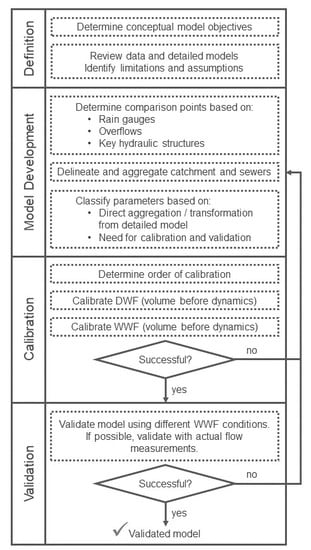An Efficient and Structured Procedure to Develop Conceptual Catchment and Sewer Models from Their Detailed Counterparts
Abstract
1. Introduction
2. Materials and Methods
2.1. Case Studies
2.1.1. Case Study 1: Ottawa, Canada
2.1.2. Case Study 2: Bordeaux, France
2.2. Modelling Approach and Software
2.3. Model Performance Criteria
3. Proposed Methodology
3.1. Project Definition
3.2. Model Development
3.3. Calibration
3.4. Validation
4. Results
4.1. Developed Conceptual Models
4.2. Level of Aggregation
4.3. Comparison of Conceptual Model with Actual Flow Rate Data
5. Discussion
5.1. Development of Conceptual Models
5.2. Level of Aggregation
5.3. Comparison to Flow Rate Measurement Data
6. Conclusions
Author Contributions
Funding
Acknowledgments
Conflicts of Interest
Appendix A
| Comp Point | DWF Calibration | WWF Calibration | WWF Validation | ||||||||||||
|---|---|---|---|---|---|---|---|---|---|---|---|---|---|---|---|
| Average Flow (l/s) | Peak Flow (l/s) | PVE (%) | PEP (%) | NSE | Event Volume (103 m3) | Peak Flow (l/s) | PVE (%) | PEP (%) | NSE (-) | Event Volume (103 m3) | Peak Flow (l/s) | PVE (%) | PEP (%) | NSE (-) | |
| Ottawa Detailed Model | |||||||||||||||
| Z1 | 246 | 307 | 101 | 1080 | 90 | 880 | |||||||||
| Z3 | 570 | 683 | 261 | 2738 | 229 | 2106 | |||||||||
| Z4 | 192 | 273 | 98 | 1239 | 83 | 1735 | |||||||||
| Z5 | 112 | 146 | 67 | 805 | 55 | 1161 | |||||||||
| Z6 | 683 | 825 | 328 | 3539 | 284 | 2628 | |||||||||
| Z9 | 939 | 1124 | 459 | 4708 | 401 | 4833 | |||||||||
| Z10 | 977 | 1171 | 475 | 4880 | 415 | 4662 | |||||||||
| Z12 | 1230 | 1499 | 615 | 6910 | 543 | 7026 | |||||||||
| Z15 | 590 | 741 | 314 | 3684 | 267 | 3919 | |||||||||
| Z16 | 645 | 808 | 349 | 4104 | 295 | 4202 | |||||||||
| Z17 | 2004 | 2388 | 979 | 8801 | 879 | 8251 | |||||||||
| Ottawa-Conceptual V1 | |||||||||||||||
| Z1 | 248 | 323 | −1 | −5 | 1.00 | 107 | 1080 | −6 | 0 | 0.97 | 100 | 979 | −11 | −11 | 0.95 |
| Z3 | 561 | 689 | 2 | −1 | 1.00 | 268 | 2738 | −3 | 0 | 0.99 | 253 | 2474 | −11 | −17 | 0.97 |
| Z4 | 191 | 274 | 1 | −1 | 0.99 | 98 | 1167 | 1 | 6 | 0.96 | 91 | 1011 | −9 | 42 | 0.84 |
| Z5 | 111 | 151 | 1 | −3 | 1.00 | 66 | 808 | 0 | 0 | 0.97 | 55 | 604 | 0 | 48 | 1.00 |
| Z6 | 672 | 837 | 2 | −1 | 1.00 | 335 | 3539 | −2 | 0 | 0.99 | 308 | 3016 | −9 | −15 | 0.98 |
| Z9 | 921 | 1147 | 2 | −2 | 1.00 | 466 | 4729 | −2 | 0 | 0.91 | 436 | 4753 | −9 | 2 | 0.88 |
| Z10 | 956 | 1194 | 2 | −2 | 1.00 | 486 | 4880 | −2 | 0 | 0.89 | 452 | 4880 | −9 | −5 | 0.94 |
| Z12 | 1198 | 1504 | 3 | 0 | 1.00 | 615 | 6936 | 0 | 0 | 0.96 | 586 | 6936 | −8 | 1 | 0.92 |
| Z15 | 594 | 723 | −1 | 2 | 1.00 | 320 | 3779 | −2 | −3 | 0.99 | 289 | 3530 | −8 | 10 | 0.95 |
| Z16 | 654 | 801 | −1 | 1 | 1.00 | 365 | 4404 | −5 | −7 | 0.98 | 329 | 4037 | −11 | 4 | 0.99 |
| Z17 | 1988 | 2434 | 1 | −2 | 1.00 | 984 | 8801 | −1 | 0 | 0.99 | 944 | 8801 | −7 | −7 | 0.99 |
| Ottawa-Conceptual V2 | |||||||||||||||
| Z1 | 248 | 325 | −1 | −6 | 1.00 | 106 | 1080 | −4 | 0 | 0.97 | 98 | 1002 | −9 | −14 | 0.87 |
| Z3 | 555 | 694 | 3 | −2 | 1.00 | 268 | 2738 | −2 | 0 | 0.99 | 251 | 2433 | −10 | −16 | 0.87 |
| Z4 | 190 | 271 | 1 | 0 | 1.00 | 99 | 1231 | −1 | 1 | 0.97 | 91 | 1029 | −10 | 41 | 0.68 |
| Z5 | 111 | 146 | 1 | 0 | 1.00 | 68 | 852 | −2 | −6 | 0.98 | 62 | 650 | −13 | 44 | 0.77 |
| Z6 | 667 | 831 | 2 | −1 | 1.00 | 335 | 3539 | −2 | 0 | 0.99 | 313 | 3080 | −10 | −17 | 0.86 |
| Z9 | 913 | 1127 | 3 | 0 | 1.00 | 467 | 4643 | −2 | 1 | 0.95 | 442 | 4751 | −10 | 2 | 0.74 |
| Z10 | 949 | 1178 | 3 | −1 | 1.00 | 486 | 4880 | −2 | 0 | 0.92 | 458 | 4880 | −10 | −5 | 0.74 |
| Z12 | 1194 | 1495 | 3 | 0 | 1.00 | 615 | 6936 | 0 | 0 | 0.98 | 591 | 6936 | −9 | 1 | 0.80 |
| Z15 | 591 | 725 | 0 | 2 | 1.00 | 319 | 3711 | −1 | −1 | 0.99 | 286 | 3555 | −7 | 9 | 0.87 |
| Z16 | 652 | 803 | −1 | 1 | 1.00 | 363 | 4272 | −4 | −4 | 0.99 | 326 | 3974 | −10 | 5 | 0.83 |
| Z17 | 2003 | 2444 | 0 | −2 | 1.00 | 986 | 8801 | −1 | 0 | 0.99 | 947 | 8801 | −8 | −7 | 0.91 |
| Comp Point | DWF Calibration | WWF Calibration | WWF Validation | ||||||||||||
|---|---|---|---|---|---|---|---|---|---|---|---|---|---|---|---|
| Average Flow (l/s) | Peak Flow (l/s) | PVE (%) | PEP (%) | NSE | Event Volume (103 m3) | Peak Flow (l/s) | PVE (%) | PEP (%) | NSE (-) | Event Volume (103 m3) | Peak Flow (l/s) | PVE (%) | PEP (%) | NSE (-) | |
| Bordeaux-Detailed | |||||||||||||||
| AB1 | 42 | 49 | 11.74 | 192.23 | 14 | 375 | |||||||||
| AB2 | 60 | 69 | 16.35 | 229.67 | 19 | 431 | |||||||||
| AB3 | 142 | 162 | 39.81 | 558.11 | 46 | 1072 | |||||||||
| AB4 | 58 | 67 | 16.64 | 274.78 | 20 | 538 | |||||||||
| AB6 | 163 | 186 | 45.07 | 581.02 | 52 | 1101 | |||||||||
| AC1 | 9 | 12 | 3.05 | 90.37 | 4 | 176 | |||||||||
| BL1 | 22 | 26 | 6.05 | 55.64 | 7 | 96 | |||||||||
| RD1 | 9 | 11 | 3.67 | 441.28 | 5 | 979 | |||||||||
| RD4 | 56 | 65 | 21.37 | 1114.45 | 30 | 2608 | |||||||||
| RD6 | 34 | 39 | 17.84 | 1568.53 | 31 | 3390 | |||||||||
| RG3 | 124 | 130 | 37.51 | 448.22 | 42 | 563 | |||||||||
| RG4 | 163 | 174 | 58.36 | 2470.28 | 76 | 4898 | |||||||||
| RG5 | 439 | 491 | 119.03 | 775.66 | 123 | 820 | |||||||||
| BG1 | 5 | 6 | 2.58 | 383.10 | 4 | 850 | |||||||||
| Bordeaux-Conceptual | |||||||||||||||
| AB1 | 42 | 48 | 0 | −1 | 0.98 | 11.62 | 200.10 | −1 | 4 | 0.97 | 14 | 491 | 5 | 31 | 0.91 |
| AB2 | 60 | 69 | 0 | 0 | 1.00 | 16.28 | 241.06 | 0 | 5 | 0.98 | 20 | 570 | 5 | 32 | 0.90 |
| AB3 | 142 | 162 | 0 | 0 | 0.97 | 39.77 | 559.35 | 0 | 0 | 0.99 | 49 | 1316 | 7 | 23 | 0.93 |
| AB4 | 58 | 66 | 0 | −1 | 1.00 | 16.81 | 274.88 | 1 | 0 | 0.99 | 22 | 667 | 11 | 24 | 0.88 |
| AB6 | 163 | 186 | 0 | 0 | 0.97 | 45.00 | 579.03 | 0 | 0 | 0.99 | 55 | 1334 | 6 | 21 | 0.93 |
| AC1 | 9 | 12 | 0 | −4 | 0.99 | 2.97 | 70.00 | −3 | −23 | 0.92 | 4 | 186 | 7 | 6 | 0.79 |
| BL1 | 22 | 26 | 0 | −1 | 0.99 | 5.93 | 58.06 | −2 | 4 | 0.92 | 7 | 124 | 1 | 29 | 0.91 |
| RD1 | 9 | 11 | 1 | 0 | 0.91 | 3.38 | 434.36 | −8 | −2 | 0.96 | 6 | 1282 | 3 | 31 | 0.94 |
| RD4 | 57 | 67 | 2 | 3 | 0.94 | 22.06 | 1226.26 | 3 | 10 | 0.86 | 35 | 3266 | 16 | 25 | 0.71 |
| RD6 | 34 | 38 | −2 | −1 | 0.90 | 18.29 | 1671.09 | 3 | 7 | 1.00 | 36 | 4747 | 15 | 40 | 0.91 |
| RG3 | 124 | 132 | 0 | 2 | 0.84 | 36.71 | 450.00 | −2 | 0 | 0.92 | 43 | 450 | 2 | −20 | 0.72 |
| RG4 | 163 | 177 | 0 | 2 | 0.84 | 57.49 | 2769.44 | −1 | 12 | 0.99 | 83 | 7271 | 10 | 48 | 0.88 |
| RG5 | 442 | 478 | 1 | −2 | 0.84 | 118.37 | 765.85 | −1 | −1 | 0.84 | 123 | 770 | 0 | −6 | 0.88 |
| BG1 | 5 | 6 | 0 | 2 | 0.89 | 2.43 | 396.42 | −6 | 3 | 0.97 | 5 | 1169 | 11 | 38 | 0.89 |
References
- Wolfs, V.; Villazon, M.F.; Willems, P. Development of a semi-automated model identification and calibration tool for conceptual modelling of sewer systems. Water Sci. Technol. 2013, 68, 167–175. [Google Scholar] [CrossRef] [PubMed]
- Achleitner, S.; Möderl, M.; Rauch, W. CITY DRAIN©—An open source approach for simulation of integrated urban drainage systems. Environ. Model. Softw. 2007, 22, 1184–1195. [Google Scholar] [CrossRef]
- Rauch, W.; Bertrand-Krajewski, J.-L.; Krebs, P.; Mark, O.; Schilling, W.; Schütze, M.; Vanrolleghem, P.A. Deterministic modelling of integrated urban drainage systems. Water Sci. Technol. 2002, 45, 81–94. [Google Scholar] [CrossRef] [PubMed]
- Gamerith, V.; Neumann, M.B.; Muschalla, D. Applying global sensitivity analysis to the modelling of flow and water quality in sewers. Water Res. 2013, 47, 4600–4611. [Google Scholar] [CrossRef] [PubMed]
- Vanrolleghem, P.A.; Mannina, G.; Cosenza, A.; Neumann, M.B. Global sensitivity analysis for urban water quality modelling: Terminology, convergence and comparison of different methods. J. Hydrol. 2015, 522, 339–352. [Google Scholar] [CrossRef]
- Mahmoodian, M.; Delmont, O.; Schutz, G. Pollution-based model predictive control of combined sewer networks, considering uncertainty propagation. Int. J. Sustain. Dev. Plan. 2017, 12, 98–111. [Google Scholar] [CrossRef]
- Meirlaen, J.; Van Assel, J.; Vanrolleghem, P.A. Real time control of the integrated urban wastewater system using simultaneously simulating surrogate models. Water Sci. Technol. 2002, 45, 109–116. [Google Scholar] [CrossRef] [PubMed]
- Weinreich, G.; Schilling, W.; Birkely, A.; Moland, T. Pollution based real time control strategies for combined sewer systems. Water Sci. Technol. 1997, 36, 331–336. [Google Scholar] [CrossRef]
- Bauwens, W.; Vanrolleghem, P.A.; Smeets, M. An evaluation of the efficiency of the combined sewer-wastewater treatment system under transient conditions. Water Sci. Technol. 1996, 33, 199–208. [Google Scholar] [CrossRef]
- Benedetti, L.; Langeveld, J.; van Nieuwenhuijzen, A.F.; de Jonge, J.; de Klein, J.; Flameling, T.; Nopens, I.; van Zanten, O.; Weijers, S. Cost-effective solutions for water quality improvement in the Dommel river supported by sewer-WWTP-river integrated modelling. Water Sci. Technol. 2013, 68, 965–973. [Google Scholar] [CrossRef]
- Willems, P. Quantification and relative comparison of different types of uncertainties in sewer water quality modeling. Water Res. 2008, 42, 3539–3551. [Google Scholar] [CrossRef] [PubMed]
- Maidment, D.R. Handbook of Hydrology; McGraw-Hill: New York, NY, USA, 1993. [Google Scholar]
- Davidsen, S.; Löwe, R.; Thrysøe, C.; Arnbjerg-Nielsen, K. Simplification of one-dimensional hydraulic networks by automated processes evaluated on 1D/2D deterministic flood models. J. Hydroinform. 2017, 19, 686–700. [Google Scholar] [CrossRef]
- Machac, D.; Reichert, P.; Albert, C. Emulation of dynamic simulators with application to hydrology. J. Comput. Phys. 2016, 313, 352–366. [Google Scholar] [CrossRef]
- Vanrolleghem, P.A.; Kamradt, B.; Solvi, A.-M.; Muschalla, D. Making the best of two hydrological flow routing models: Nonlinear outflow-volume relationships and backwater effects model. In Proceedings of the 8th International Conference on Urban Drainage Modelling, Tokyo, Japan, 7–11 September 2009. [Google Scholar]
- Guo, L.; Tik, S.; Ledergerber, J.M.; Santoro, D.; Elbeshbishy, E.; Vanrolleghem, P.A. Conceptualizing the sewage collection system for integrated sewer-WWTP modelling and optimization. J. Hydrol. 2019, 573, 710–716. [Google Scholar] [CrossRef]
- Kroll, S.; Wambecq, T.; Weemaes, M.; Van Impe, J.; Willems, P. Semi-automated buildup and calibration of conceptual sewer models. Environ. Model. Softw. 2017, 93, 344–355. [Google Scholar] [CrossRef]
- Muschalla, D.; Leimgruber, J.; Maier, R.; Tscheikner-Gratl, F.; Kleidorfer, M.; Wolfgang, R.; Ertl, T.; Kretschmer, F.; Sulzbacher, R.M.; Neunteufel, R. DATMOD—Rehabilitation and Adaptation Planning of Small and Medium-Sized Sewer Systems; Bundesministerium für Land- und Forstwirtschaft, Umwelt und Wasserwirtschaft: Wien, Österreich, 2015. (In German) [Google Scholar]
- Wolfs, V. Conceptual Model Structure Identification and Calibration for River and Sewer Systems. Ph.D. Thesis, KU Leuven, Leuven, Belgium, 2016. [Google Scholar]
- Muschalla, D.; Schütze, M.; Schroeder, K.; Bach, M.; Blumensaat, F.; Gruber, G.; Klepiszewski, K.; Pabst, M.; Pressl, A.; Schindler, N.; et al. The HSG procedure for modelling integrated urban wastewater systems. Water Sci. Technol. 2009, 60, 2065–2075. [Google Scholar] [CrossRef] [PubMed]
- Wolfs, V.; Meert, P.; Willems, P. Modular conceptual modelling approach and software for river hydraulic simulations. Environ. Model. Softw. 2015, 71, 60–77. [Google Scholar] [CrossRef]
- Gernaey, K.V.; van Loosdrecht, M.C.M.; Henze, M.; Lind, M.; Jørgensen, S.B. Activated sludge wastewater treatment plant modelling and simulation: State of the art. Environ. Model. Softw. 2004, 19, 763–783. [Google Scholar] [CrossRef]
- Rieger, L.; Gillot, S.; Langergraber, G.; Ohtsuki, T.; Shaw, A.; Takacs, I.; Winkler, S. Guidelines for Using Activated Sludge Models. IWA Task Group on Good Modelling Practice; Scientific and Technical Report No. 22; IWA Publishing: London, UK, 2012. [Google Scholar]
- Refsgaard, J.C.; Henriksen, H.J.; Harrar, W.G.; Scholten, H.; Kassahun, A. Quality assurance in model based water management-review of existing practice and outline of new approaches. Environ. Model. Softw. 2005, 20, 1201–1215. [Google Scholar] [CrossRef]
- Scholten, H.; Kassahun, A.; Refsgaard, J.C.; Kargas, T.; Gavardinas, C.; Beulens, A.J.M. A methodology to support multidisciplinary model-based water management. Environ. Model. Softw. 2007, 22, 743–759. [Google Scholar] [CrossRef]
- Pieper, L. Development of a Model Simplification Procedure for Integrated Urban Water System Models—Conceptual Catchment and Sewer Modelling. Master’s Thesis, Université Laval, Québec, QC, Canada, 2017. [Google Scholar]
- Meirlaen, J. Immission Based Real-Time Control of the Integrated Urban Wastewater System. Ph.D. Thesis, Universiteit Gent, Ghent, Belgium, 2002. [Google Scholar]
- Euler, G. A hydrological approximation for the calculation of waves in circular pipes. In Wasser und Boden; Heft 2, TU Darmstadt: Darmstadt, Germany, 1983; pp. 85–88. (In German) [Google Scholar]
- Mehler, R. Combined Sewage Treatment—Process and Modeling; Heft 113; Mitteilungen des Institutes für Wasserbau und Wasserwirtschaft, TU Darmstadt: Darmstadt, Germany, 2000. (In German) [Google Scholar]
- Vanhooren, H.; Meirlaen, J.; Amerlinck, Y.; Claeys, F.; Vangheluwe, H.; Vanrolleghem, P.A. WEST: Modelling biological wastewater treatment. J. Hydroinform. 2003, 5, 27–50. [Google Scholar] [CrossRef]
- Hauduc, H.; Neumann, M.B.; Muschalla, D.; Gamerith, V.; Gillot, S.; Vanrolleghem, P.A. Efficiency criteria for environmental model quality assessment: A review and its application to wastewater treatment. Environ. Model. Softw. 2015, 68, 196–204. [Google Scholar] [CrossRef]

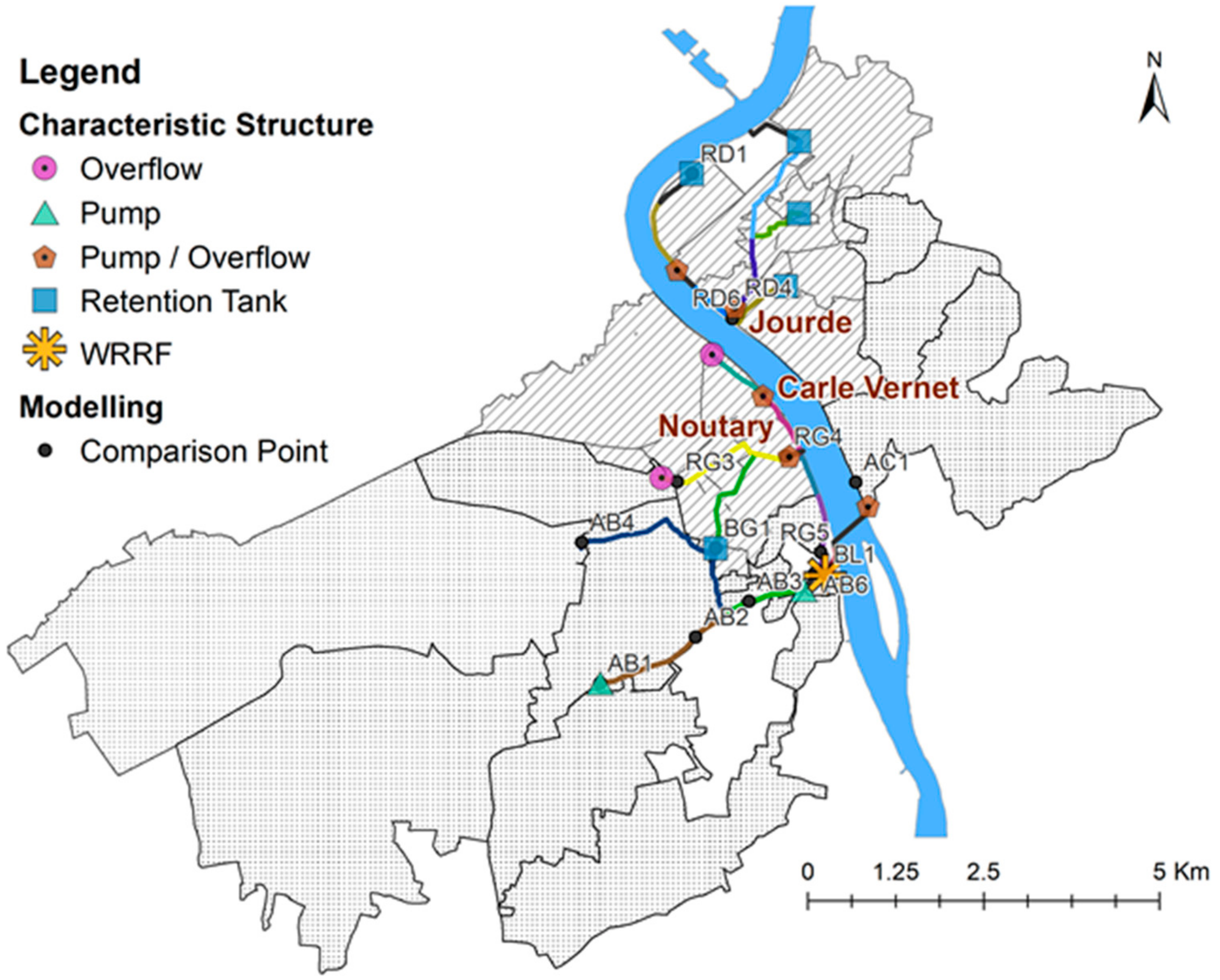
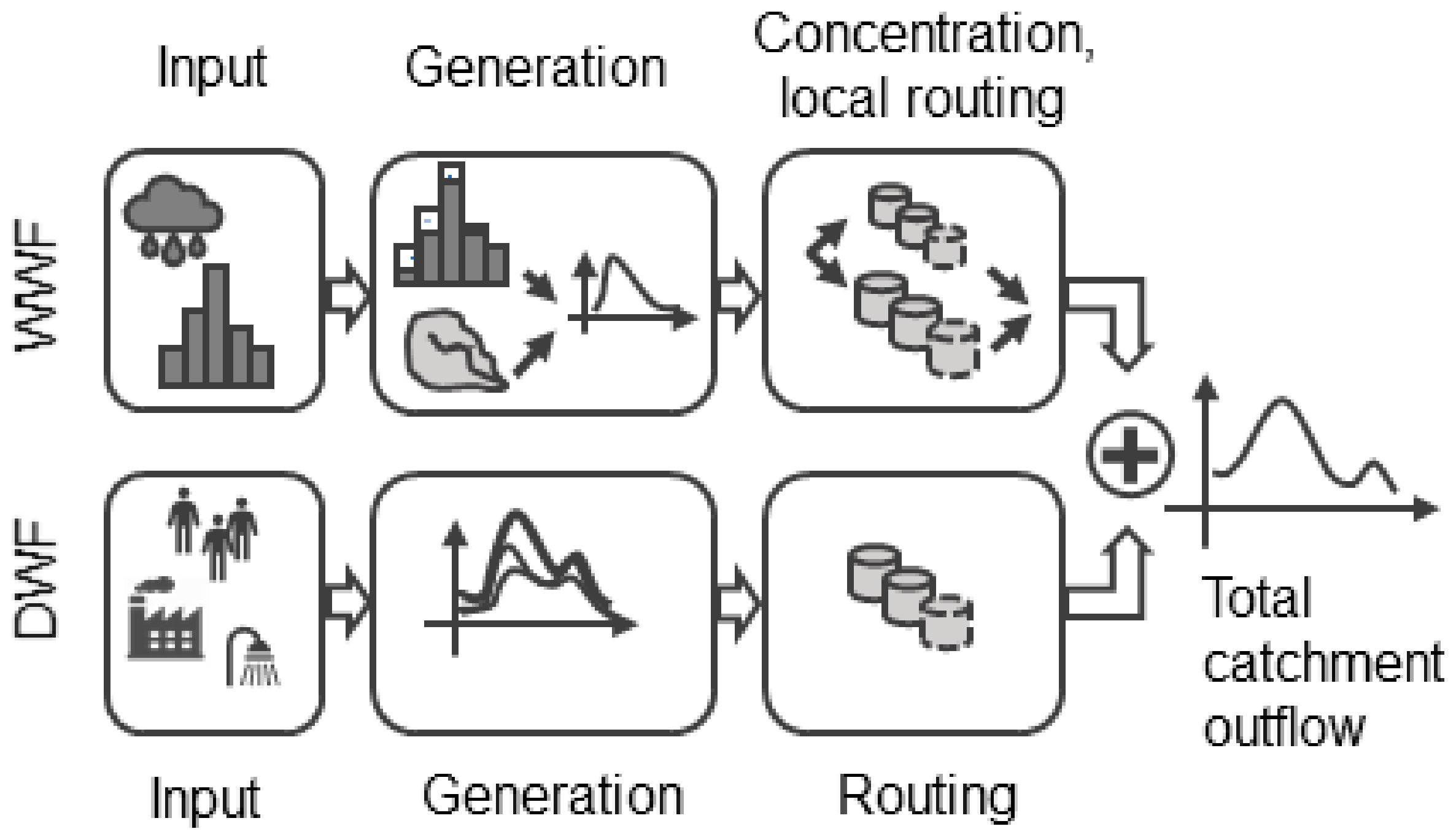
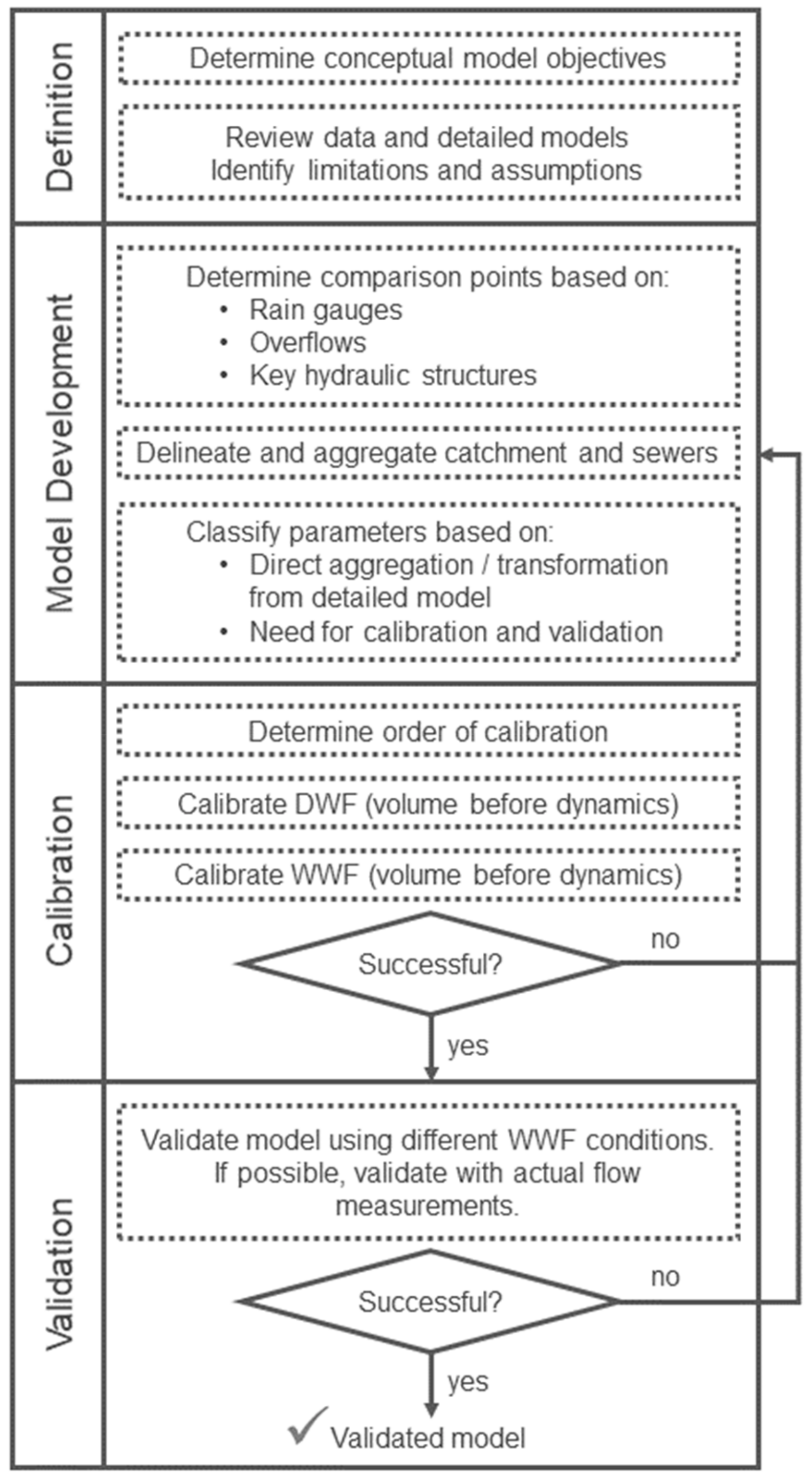
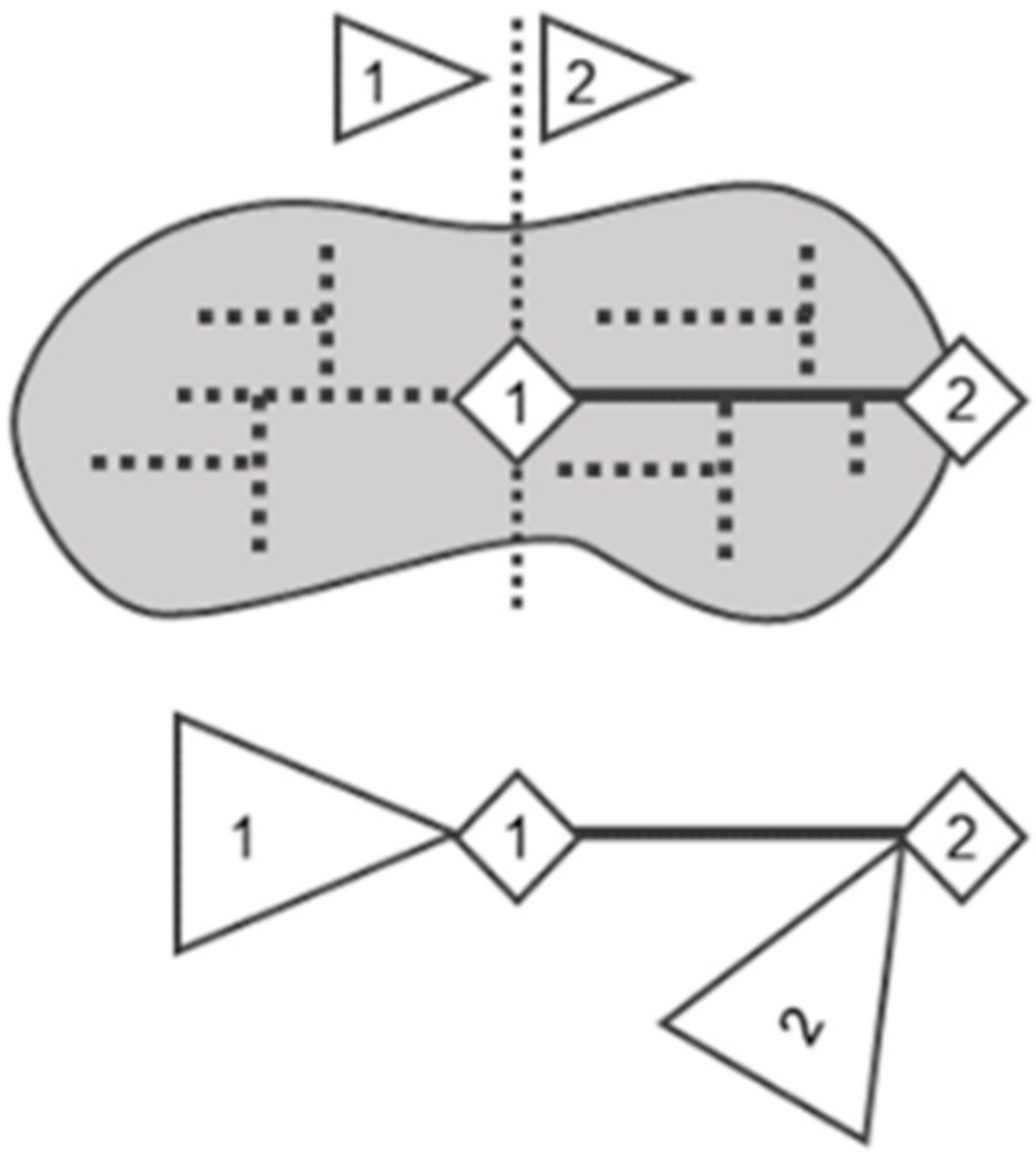
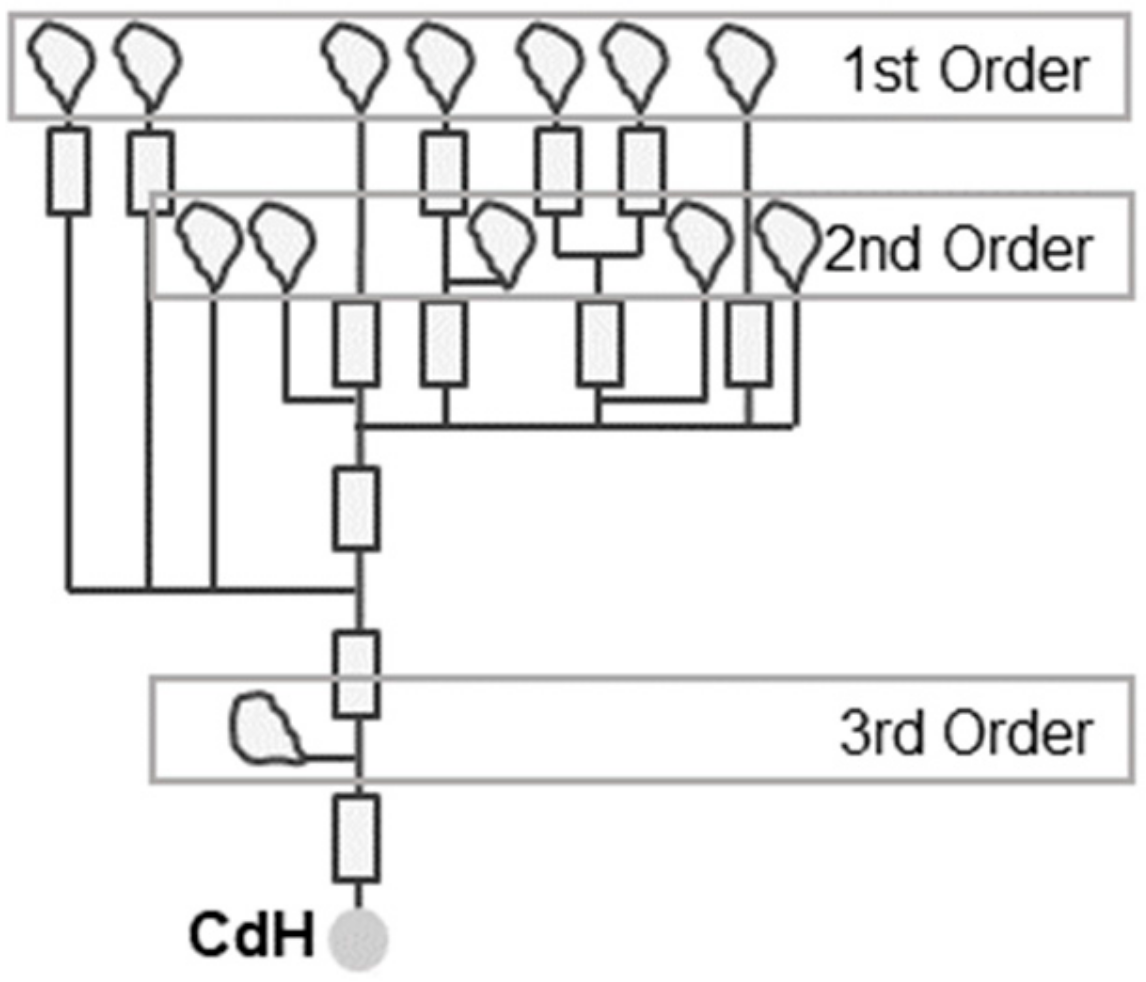

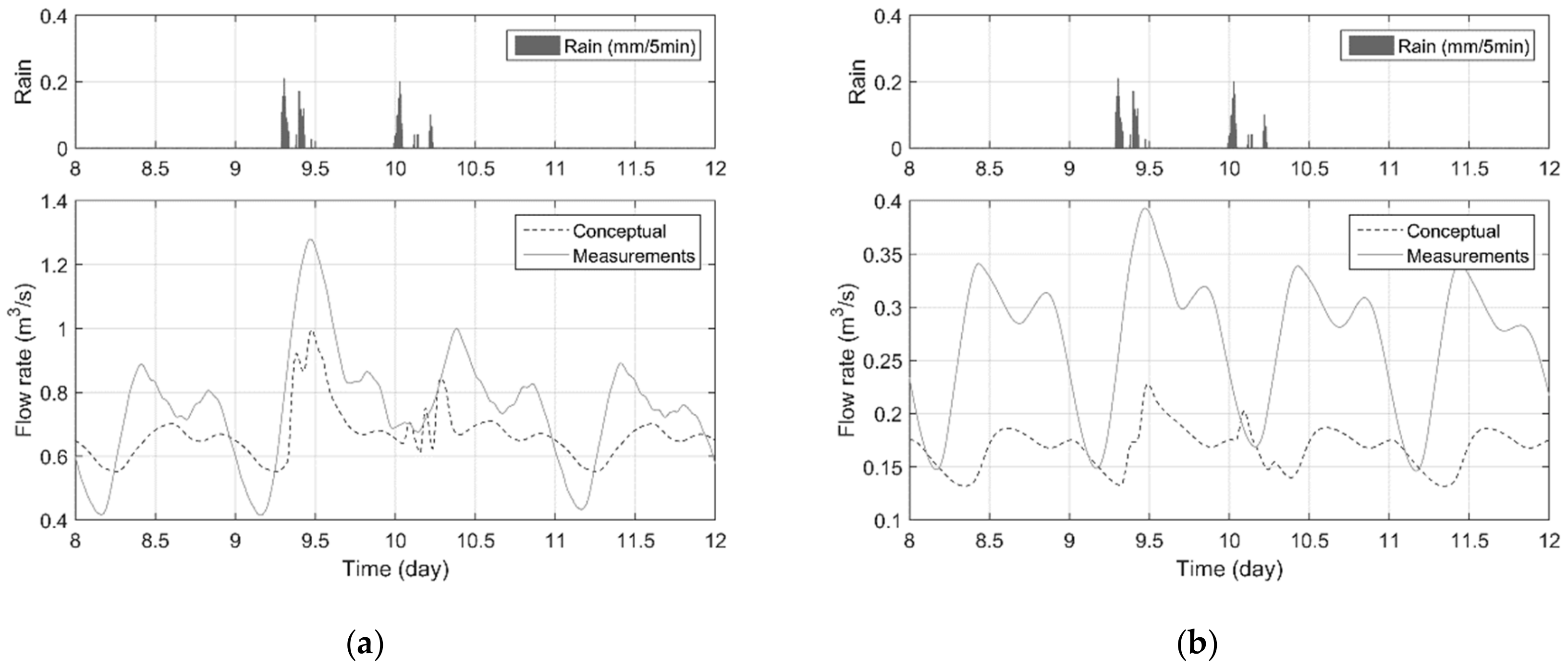
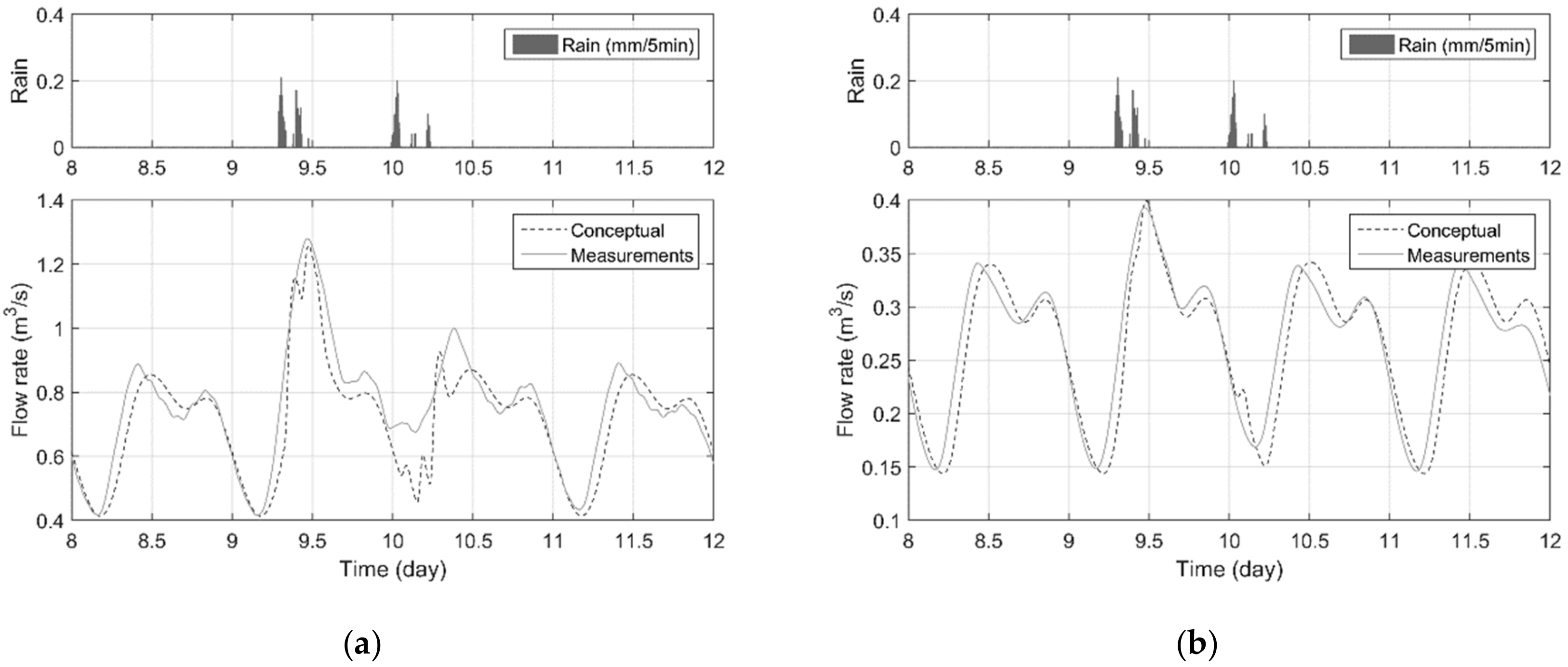
| Step | Ottawa | Bordeaux |
|---|---|---|
| Objectives conceptual model | Fast conceptual model for later extension to an integrated model (including WRRF). Simulation time of a rain event < 1 min. Calibration: NSE > 0.8 Validation: NSE > 0.65 | Fast conceptual model valid over a wide range of conditions to be extended with a water quality model. Simulation time of a rain event < 1 min. Calibration: NSE > 0.8 Validation: NSE > 0.65 |
| Detailed models | SWMM 5 model (United States Environmental Protection Agency), built in 2013 to evaluate pipe capacities and overflows for large storm events (e.g. 100-year return period). | Mike Urban model (DHI, Horsholm, Denmark), built in 2012 to evaluate pumping capacities and overflows under WWF conditions for current and future scenarios (10 to 20 years). |
| Available data | 7 rain gauges | 4 rain gauges and 8 flow measurements |
| Performance Indicator | DWF Calibration | WWF Calibration | WWF Validation |
|---|---|---|---|
| Ottawa Model V1 | |||
| Average NSE | 1.00 | 0.96 | 0.95 |
| Range NSE | 0.99–1.00 | 0.89–0.99 | 0.84–1.00 |
| Bordeaux | |||
| Average NSE | 0.93 | 0.95 | 0.87 |
| Range NSE | 0.84–1.00 | 0.84–1.00 | 0.71–0.94 |
| Model | Ottawa | Bordeaux | |||
|---|---|---|---|---|---|
| Detailed | Conceptual V1 | Detailed | Conceptual | ||
| Catchments | # | 271 | 52 | 57 | 20 |
| Conduits | # | 2600 | 33 | 783 | 16 |
| DWF (2 days) | (min) | 8.03 | 0.53 | 7.64 | 0.37 |
| Speedup factor | 15 | 21 | |||
| WWF (3 days) | (min) | 30.7 | 0.63 | 10.7 | 0.92 |
| Speedup factor | 49 | 12 | |||
| Indicator | Attribute | Model V1 | Model V2 |
|---|---|---|---|
| Catchments | Number of sub-catchments | 52 | 22 |
| Average/median size | 146/102 ha | 289/192 ha | |
| Size range | 26–435 ha | 26–732 ha | |
| Sewers | Number of conduits | 33 | 17 |
| Average/median length | 1480/1280 m | 2580/1490 m | |
| Length range | 100–3000 m | 770–7720 m | |
| Speedup factor | DWF (2 days) | 15 | 24 |
| WWF (3 days) | 49 | 81 | |
| Performance | NSE DWF calibration average | 1.00 | 1.00 |
| NSE DWF calibration range | 0.99–1.00 | 1.00–1.00 | |
| NSE WWF calibration average | 0.96 | 0.97 | |
| NSE WWF calibration range | 0.89–0.99 | 0.92–0.99 | |
| NSE WWF validation average | 0.95 | 0.81 | |
| NSE WWF validation range | 0.84–1.00 | 0.68–0.91 |
| Comparison Point | Measured | Conceptual (Calibrated on Detailed Model Only) | Conceptual (DWF Recalibrated on Measurements) | ||||||
|---|---|---|---|---|---|---|---|---|---|
| Vol. | Vol. | PVE | PEP | NSE | Vol. | PVE | PEP | NSE | |
| (103 m3) | (103 m3) | (%) | (%) | (-) | (103 m3) | (%) | (%) | (-) | |
| CdH total | 259 | 231 | −11 | −22 | 0.31 | 247 | −5 | −2 | 0.80 |
| CdH Tributary 1 | 93 | 58 | −37 | −42 | −2.47 | 92 | −1 | 2 | 0.85 |
| CdH Tributary 2 | 150 | 162 | 8 | −10 | 0.59 | 139 | −7 | −3 | 0.69 |
| CdH Tributary 3 | 9 | 8 | −14 | −25 | −0.47 | 10 | 9 | 5 | 0.65 |
| CdH Tributary 4 | 7 | 3 | −56 | −66 | −1.99 | 6 | −13 | −24 | 0.72 |
| Jourde Outflow | 40 | 41 | 2 | −16 | 0.70 | 38 | −7 | 5 | 0.52 |
| Jourde Overflow | 0 | 3 | n.a. | n.a. | n.a. | 2 | n.a. | n.a. | n.a. |
| Carle Vernet Outflow | 48 | 61 | 26 | −18 | −0.10 | 46 | −5 | −18 | 0.67 |
| Noutary Inflow | 61 | 59 | −2 | −17 | 0.44 | 55 | −10 | −12 | 0.60 |
© 2019 by the authors. Licensee MDPI, Basel, Switzerland. This article is an open access article distributed under the terms and conditions of the Creative Commons Attribution (CC BY) license (http://creativecommons.org/licenses/by/4.0/).
Share and Cite
Ledergerber, J.M.; Pieper, L.; Binet, G.; Comeau, A.; Maruéjouls, T.; Muschalla, D.; Vanrolleghem, P.A. An Efficient and Structured Procedure to Develop Conceptual Catchment and Sewer Models from Their Detailed Counterparts. Water 2019, 11, 2000. https://doi.org/10.3390/w11102000
Ledergerber JM, Pieper L, Binet G, Comeau A, Maruéjouls T, Muschalla D, Vanrolleghem PA. An Efficient and Structured Procedure to Develop Conceptual Catchment and Sewer Models from Their Detailed Counterparts. Water. 2019; 11(10):2000. https://doi.org/10.3390/w11102000
Chicago/Turabian StyleLedergerber, Julia M., Leila Pieper, Guillaume Binet, Adrien Comeau, Thibaud Maruéjouls, Dirk Muschalla, and Peter A. Vanrolleghem. 2019. "An Efficient and Structured Procedure to Develop Conceptual Catchment and Sewer Models from Their Detailed Counterparts" Water 11, no. 10: 2000. https://doi.org/10.3390/w11102000
APA StyleLedergerber, J. M., Pieper, L., Binet, G., Comeau, A., Maruéjouls, T., Muschalla, D., & Vanrolleghem, P. A. (2019). An Efficient and Structured Procedure to Develop Conceptual Catchment and Sewer Models from Their Detailed Counterparts. Water, 11(10), 2000. https://doi.org/10.3390/w11102000





